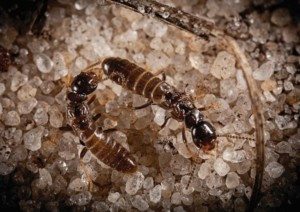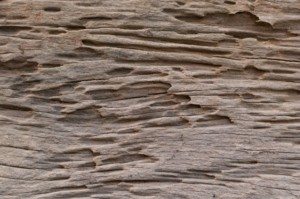Termites and carpenter ants are no joke, causing severe damage to your home. Both are small and well hidden, meaning they can go unnoticed for quite some time. These wood-destroying insects have some key differences, though, which are critical in understanding the signs early on and determining the correct treatment should you have an infestation.
What do termites look like?
Get A Free Quote
Residential
(281) 561-9999
Commercial
(800) 562-8103
Although you may never even see a termite or carpenter ant before it’s too late, the most obvious place to start is with what they look like. Take a look at the two images below. Think you know which of these is a termite?


The ant is the left image, and the termite is on the right. Termites have a more rectangular body shape, where ants have a “waist”. In this example only the ant has wings, however both insects go through cycles where they have wings. An ant’s back two wings are usually shorter than its abdomen, where a termite’s wings extend much further past their abdomen. Termite wings fall off easily, so if you see them in your home they may be nesting close by and a professional should be called immediately for an inspection.
Appetite
True/False: Termites and carpenter ants eat wood, which is why they are so easily mistaken.
Answer: False! Because both insects destroy wood, it is thought that carpenter ants also eat wood. In actuality, carpenter ants prefer pet food, sweets, and meat, and gain no nutritional value from eating wood. Instead, they dig into wood creating tunnels for nesting. Carpenter ants push the wood through tunnel openings, so if you see small piles of what looks like wood shavings it could be a sign of a carpenter ant infestation.
Damage
Even though carpenter ants don’t eat wood, they do cause wood damage just like termites. By looking closely at the tunnels they create, you can determine which pest you are dealing with. Carpenter ants keep their tunnels (also called galleries) clean and polished with tiny holes where they push out debris, while termite tunnels contain mud and soil. See if you can spot the difference.


If you guessed termite damage was the left and carpenter ant was the right, you are correct. Carpenter ants form cleaner tunnels, and you can spot the holes where debris is pushed through.
Why Do You Have Them?
Carpenter ants and most termite species also gravitate towards moisture. Standing water, leaky faucets and dripping AC window units may create an opportunity for termites and carpenter ants.
Cracks in foundations, windows and doors also allow termites and carpenter ants can allow them access to wood, where they chew/dig tunnels through existing structures.
Getting Rid of Termites and Carpenter Ants
Carpenter ants and termites have more differences than you think, which is why you need to seek a professional to help you determine a) what you are dealing with, and b) what the best course of action will be. Generally, carpenter ants can be controlled through exclusion methods – sealing gaps and cracks, and eliminating food and water sources.
Termite infestations require much more involvement and treatment methods vary depending on severity and type of termite. Holder’s Pest Solutions offers free termite inspections where we’ll diagnose your pest problem and provide a recommended action plan.

